By Stephanie Tran Rojas
The Albert Food Centre was where I went for breakfast on my first weekend in Singapore. As a nursing student at the University of Pennsylvania, I’d come here to embark on an eight-week internship at the Lien Centre for Social Innovation. This eating place was a stone’s throw from my hostel, but in the short time it took me to get there, I noticed many elderly people around me. On arriving, it was once again the older folks—stall owners, cooks and cleaners—who caught my attention. A good number of seniors were diners too, such as the 50-something-looking man I was sharing a table with. I struck a conversation with Mr Lim (not his real name), who works as a cleaner in hotels. During our chat, he explained that he frequents Albert Food Centre during lunch breaks because his friend runs a nearby drinks stand.
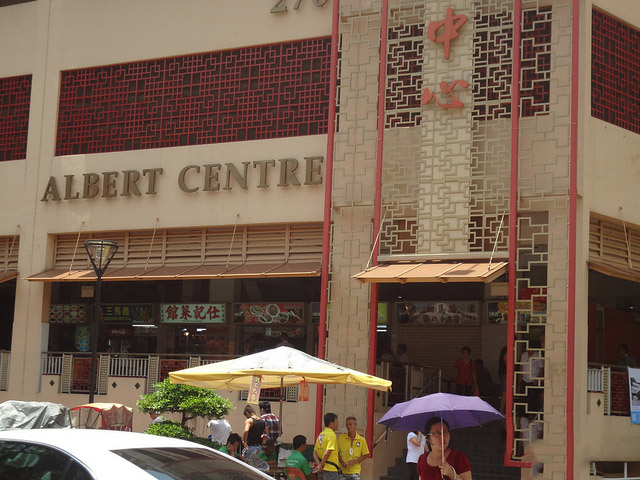
Photo by Dickson Phua via Flickr
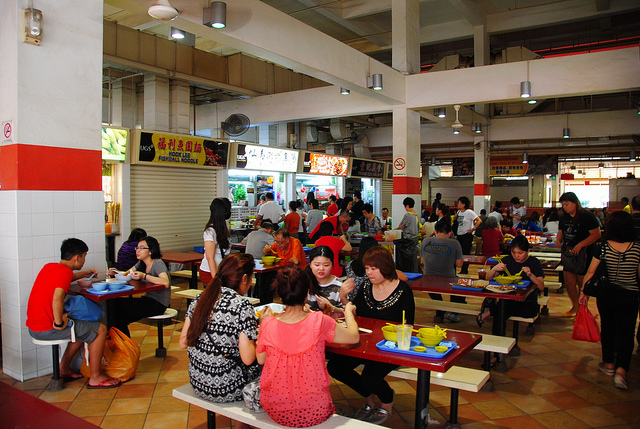
Photo by LW Yang via Flickr
Hearing that, I immediately wondered why he, as well as the older Singaporeans around me, were doing labour-intensive work. In the States, it’s more common to see high-schoolers or those in their twenties take on the more physical jobs, while—based on my personal observations—Americans over the age of 50 typically do more sedentary, office-type work. Sparked by this curiosity, I decided to do more research on Singapore's seniors.
Preceding Events
In fact, I’d taken an interest in the experiences of elderly people—more specifically, their quality of life—prior to my stay in Singapore. And two particular events had prefaced this interest.
Thailand and China
Several months earlier, in June, I’d travelled with my course mates to Chiang Mai, Thailand, to visit the residents of a local aged home to offer snacks. There was a certain room we weren’t permitted to enter, but from the outside, we could see a man desperately fighting to get out of his bed. My professor, afraid the elderly man might fall and injure himself, went in to assist. However, an aide supervising this area saw this and asked her to leave. She obliged, perhaps assuming the aide would take over from there, but the man was simply left standing in the middle of the room. The aide had left without leading him back to his bed or getting him any snacks. When my professor returned to our group, she said solemnly, “I know why they didn’t want us in there. I smelled pressure ulcers.”
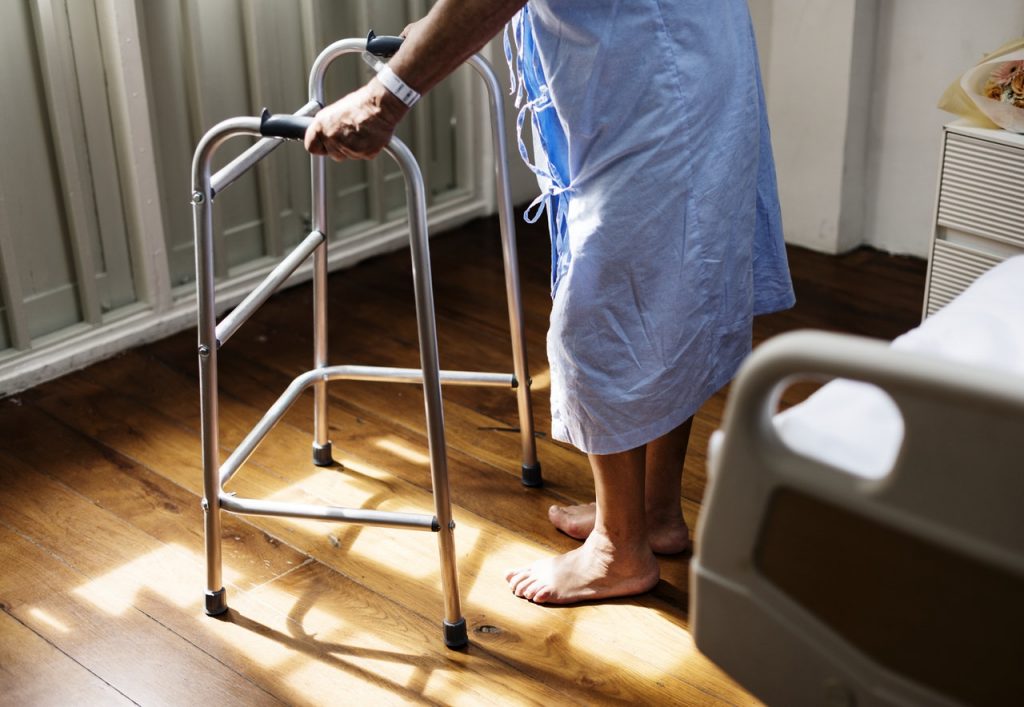
Image via Pexels
I was saddened by this encounter, especially when I considered others who might be in a similar plight: bedridden, frail and neglected. A month after Thailand, I visited Beijing, China on another school trip. There, I saw an entirely different picture of ageing. Every evening, at the public park next to my hotel, many old folks would gather as a community. In that space, the senior citizens would bring stereos and dance to the tunes of old songs, play music, enjoy card games with one another, or relax with their grandchildren. As the night wore on, the park would resemble the venue of a large, extended family gathering. On the few occasions that I visited this park, I found myself surrounded by an active bunch of elderly folks who appeared lively and full of zest. They were all physically independent, energetic and fully engaged in activities they clearly seemed to enjoy. Astounded by such a sight, I immediately thought, “Now this is the ideal way to age.”
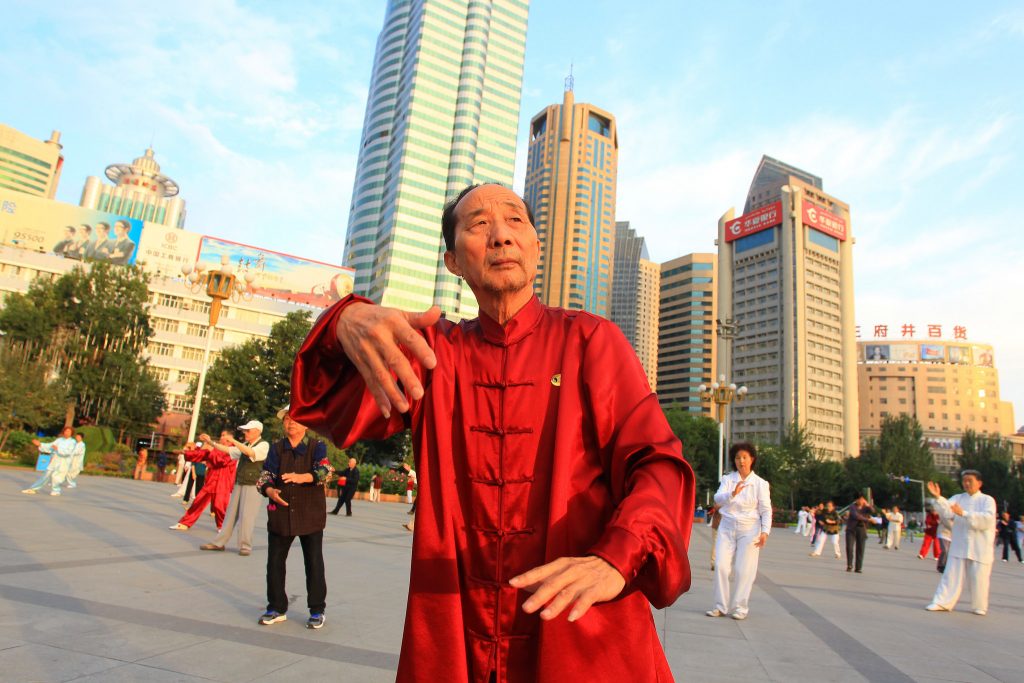 Photo by Asian Development Bank via Flickr
Photo by Asian Development Bank via Flickr
I’d like to point out at this juncture, however, that my earlier experience in Thailand does not represent the country’s eldercare situation as a whole, but is rooted purely in my personal experience there. It’s important to note that neglect and mistreatment can occur in any facility, anywhere in the world. Similarly, the lively picture of ageing I witnessed in China does not speak for the entire nation’s elderly population. It is impossible to compare the experiences of residents in an old-age home with those of old folks at a public park. The reason I chose to detail my two very different encounters with elderly persons in foreign countries is to provide context to my topic of research on Singaporean’s seniors and their quality of life. I was, after all, about to embark on my internship at the island city-state in Southeast Asia, known for its ultra-modernity and third highest GDP per capita. How would older Singaporeans fare in terms of quality of life?
Singapore’s Pioneer Generation
Elderly persons are the fastest growing demographic in Singapore, with people over the age of 65 projected to make up 47 per cent of the whole population by 2050. It therefore surprised me when I didn’t immediately notice them on my first day here. For one, I didn’t spot too many of them hanging out at places I considered to be “typical” spots, like park benches or community spaces.
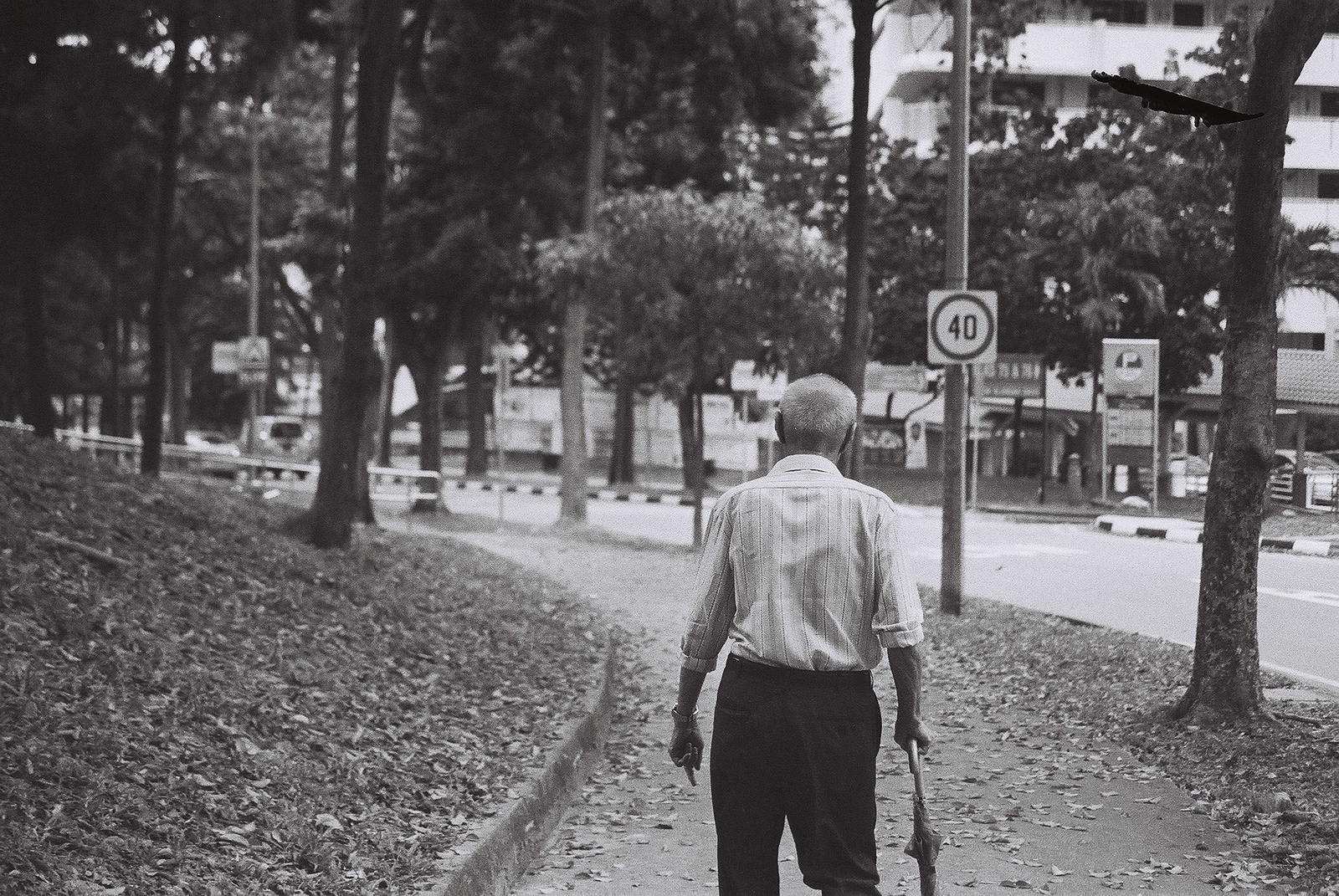 Photo by Gramicidin via Flickr
Photo by Gramicidin via Flickr
But after my weekend breakfast at Albert Food Centre, I soon realised why. They were busy working. Singapore’s workforce comprises many employees aged 70 years and older, a number that has increased from about 16,000 in 2006 to about 43,000 in 2016. Termed the “Pioneer Generation” to allude that these individuals’ contributions to Singapore’s nation-building and economic success, many of them remain actively employed in their golden years. According to the Ministry of Manpower, of the population retiring in 2011, 92 out of the 97 per cent accepted the offer to keep working. The more highly educated “pioneers” take on part-time consulting work or have their contracts extended past the age of 67, but the most visible portion of them can be seen bussing tables at hawker centres or working as security guards. It seems reasonable to opt for continued employment over retirement to avoid a sedentary life at home. However, the majority of Singapore’s “pioneers” who toil in laborious, menial jobs often do so out of economic necessity—there are bills to be paid and their children cannot always provide for them. Healthcare costs are another factor preventing them from retiring: medical treatment for illnesses and medication for age-related conditions can quickly deplete one’s life’s savings. Simply put, not everyone can afford to retire in Singapore.
“Good” Quality of Life: What Does That Look Like?
“Quality of life” (QOL) is highly subjective, and most people have their own definition of what it means to have “good” QOL. The Harvard Study on Adult Development found that meaningful relationships “associated with resilience, contentment and happiness” contributed most to a sense of wellness among adults. However, for purposes of this article alone, I will describe good QOL as living with human dignity, having meaningful social interactions and well-managed health and personal finances.
Interested to find out if older Singaporeans (aged 65 and above) themselves believed they had good QOL, I began a series of interviews.
Interviews with Service Professionals
I chatted with Lily Phang, the co-founder of Homage, a homecare social enterprise. Ms Phang is herself a caregiver to her mother-in-law with dementia, and during our interview she shared both her professional and personal insights. A firm believer that one should “never underestimate the psychosocial needs” of the elderly, she stated that in her experience most older folks just want someone to pay close attention to them and be responsive to their needs. Ms Phang further suggested a strong link between independence and QOL. She mentioned that many seniors with physical limitations often develop a heavy reliance on caregivers (family, domestic helpers or nurses) to do everything for them. Although this dependency causes them to lose a sense of dignity and freedom, their fear of being a “burden” and imposing on their caregivers often prevents them from venturing outside their homes. As a result, they feel isolated and disempowered. Therefore, through Homage’s services, she hopes to restore their sense of independence and freedom.
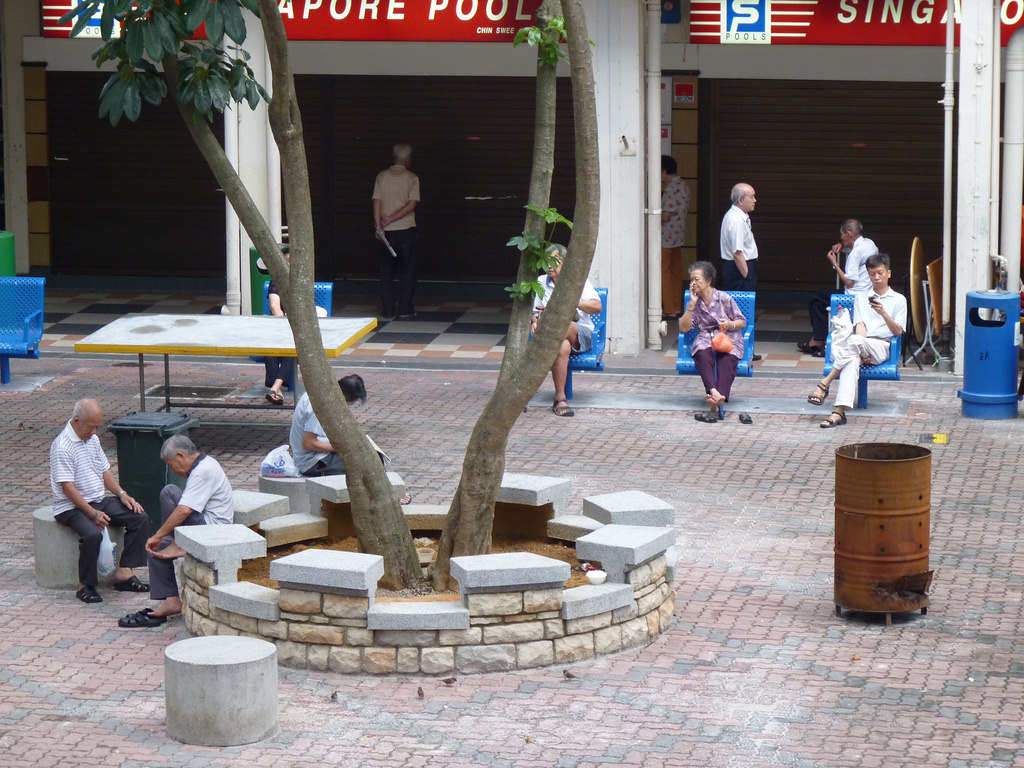 Photo by Bernard Oh via Flickr
Photo by Bernard Oh via Flickr
This link between independence and QOL was also mentioned by Vanessa Keng, the cofounder of The Golden Concepts, an e-tailer of innovative equipment for the elderly. Ms Keng started her social enterprise in 2011 with her former schoolmate Chang Xi after they noticed that the eldercare devices market in Singapore focused primarily on medical and rehabilitative aspects, and lacked innovation. Products from The Golden Concepts, on the other hand, are consciously designed to promote independence and mobility, such as their foldable and adjustable walking canes, seat assist cushions, and car accessories that aid getting in and out of vehicles. On why some older Singaporeans have a poorer QOL, she believed this was due to “a high dependence on others, social isolation and chronic medical conditions.” I asked Ms Keng how she’d describe someone with good QOL and she said that they’d be “more positive and open-minded, physically mobile, mentally sharp, and interact well with others”. According to her customers (mostly seniors), most saw immobility and a lack of physical activity as barriers to attaining a better QOL.
Fighting to maintain our mobility and independence in our old age may not be easy, but that is what retiree Donna Benson has done.
Donna’s Story
I first got to know Donna Benson a few years ago through a dragonboating team based in San Diego, California. A former US Naval Reserve and Administrative Department Head, 77-year-old Donna is a free-spirited and adventurous lady despite her advanced years. In 1999, Donna experienced a traumatic brain injury at the age of 58, requiring her to undergo intensive speech and physical therapy. When she returned to her job, she had to work at a desk with no phone and no customer service interaction. For the next three months, she was only allowed two responsibilities for half-days. However, over time and with hard work, her condition improved. Eventually, she relearned all her necessary tasks and was even able to ride a bicycle again. She even participated in San Diego’s annual bike ride and went on to join a bike race that spanned seven days from Missoula to Billings in Montana. After her race, however, Donna was hit by an irregular sense of fatigue that prompted her to go for a physical examination. She was later diagnosed with colon cancer and underwent six months of chemotherapy. When she completed her treatment, she decided it was time to retire from her job. Donna has since recovered, but has had to make certain lifestyle adjustments due to her history of brain injury and cancer, in addition to the effects of ageing. For instance, she needs physical reminders about what most people would have no trouble remembering (such as where they parked and who they met), and always carries a notepad with her to jot down information. And though she lives alone (she never married), Donna is hardly isolated and depressed—she keeps active playing basketball and dragonboating, in addition to volunteering at the San Diego Brain Injury Foundation. Despite her age and condition, she has managed to assert her independence by staying physically active and engaging often with people in her community.
“Clinical” Perspectives
Although I had not included healthcare access in my personal definition of quality of life, I wanted to find out the extent to which an elderly person’s physical well-being impacts their QOL. As such, I visited a geriatric outpatient clinic in Singapore to speak with physicians and patients.
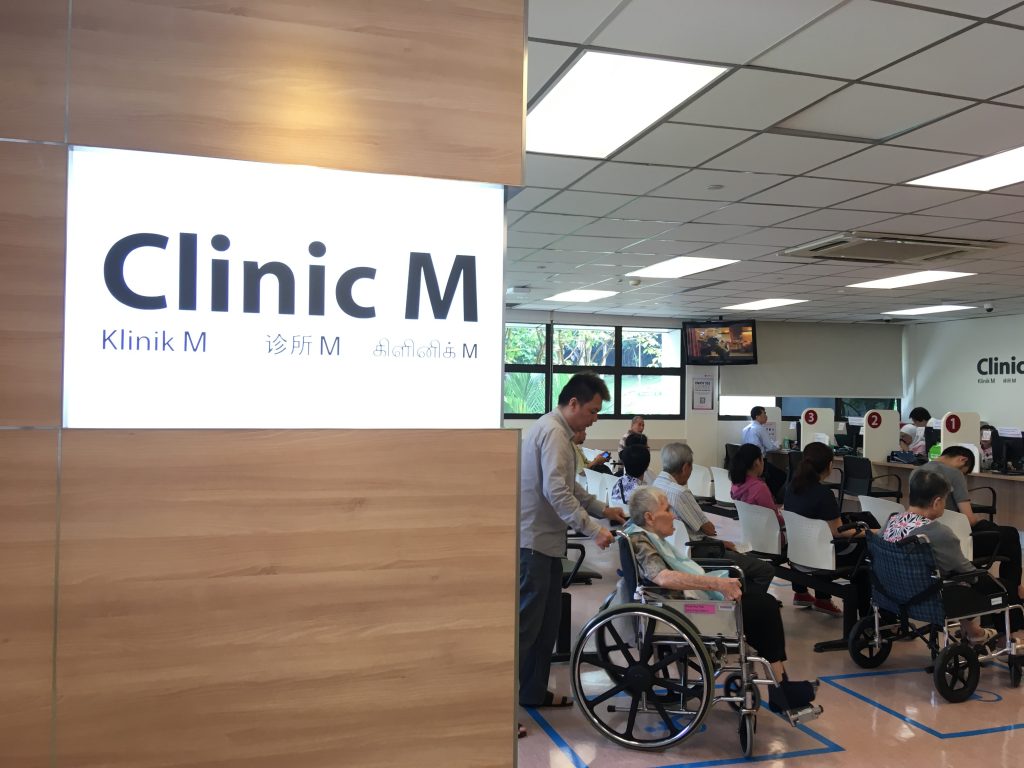
Photo by author
At the National University Hospital’s Department of Geriatric Medicine, I chatted with Dr Ng Shu Ee, a Geriatrician and Assistant Professor at the Yong Loo Lin School of Medicine.
Dr Ng, who practises at NUH’s outpatient clinic and wards, formerly ran a transitional care programme that facilitated patients’ move from hospitals back into their own homes and communities. When I asked Dr Ng about the sorts of issues her elderly patients struggle with, she cited loneliness and finding the right options for home-based care. My next question to her was how she’d personally define a good quality of life, and she offered the following criteria: autonomy, conscious self-control, good relationships and no dietary restrictions. Going by those parameters, many of her patients fall short, at least regarding their freedom over food choices. To preserve their health and manage chronic conditions, many older folks have to limit their intake of fat, salt and sugar. No longer able to freely indulge in the foods they love, this causes them to feel a dip in their QOL. As for patients who appear to have a higher QOL, Dr Ng observed that they tend to have meaningful relationships with others. She explained how we reach our physical peak in our late teens and early twenties, and start ageing once we reach our thirties. However, we also have the most social development in those early years. “Deep relationships don’t start in your seventies, they form in your twenties,” she stated, and as a result, people who forge social bonds early on in life are less likely to be lonely in their old age. On the contrary, someone who did not have a social network outside of their jobs would feel a loss of identity once they left employment. Dr Ng also expressed the importance of having work-unrelated hobbies. Many Singaporeans fear retirement because they think that without a 9-to-5, they would develop dementia or become inactive. However, with a variety of physically and mentally engaging hobbies, work need not be one’s sole source of stimulation. She believed many people devote too much time to career progression instead of maintaining and developing relationships and cultivating good habits for health. As a result, the impact of such decisions follows them past their retirement.
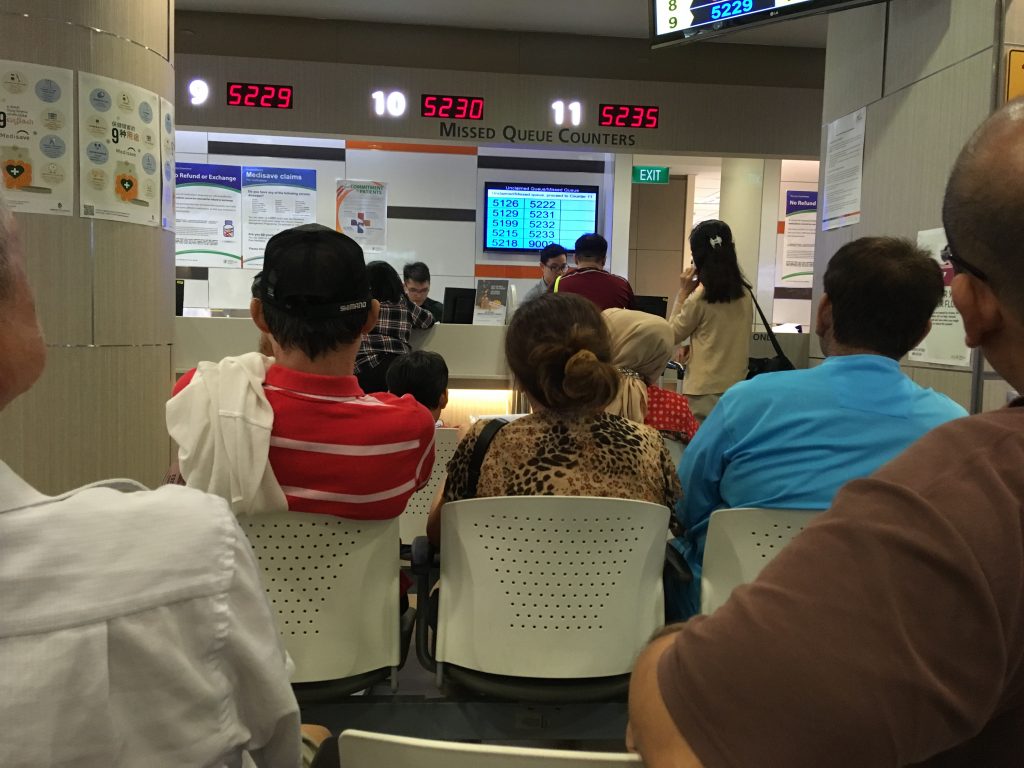
Photo by author
Hoping next to get insights from the elderly patients themselves, I ventured to the Singapore General Hospital’s Geriatric Outpatient Clinic. At the waiting area, it was difficult to find people who were willing to participate in my informal interview—many balked at the mention of “elderly” and “quality of life”. One individual even said, “I don’t think I want to get into that.” Though I was disappointed, I could understand their reluctance—this was a deeply personal topic and most were not comfortable speaking on behalf of the entire “pioneer generation”. Eventually I found several willing participants. While awaiting their prescriptions at the SGH pharmacy, they spoke to me on condition of their anonymity. Most didn’t feel they had a bad QOL, except that they had to work extremely hard, even at their age, to pay for their medical bills and cover their basic cost of living.
Dilan (not his real name) was the only interviewee who considered his QOL to be bad, primarily due to his financial instability. The 63-year-old works as a part-time cleaner not for mental stimulation or to remain physically active, but because without a job he wouldn’t be able to afford even his basic necessities. I asked what he did outside of work and he said he keeps fit by walking, jogging and doing push-ups—he even joked that his good health enabled him to “have girlfriends”. But on a more serious note, Dilan observed that many of his peers lose the time, energy and motivation to maintain social relationships, and how that negatively affects their quality of life. 59-year-old Sim (not his real name), on the other hand, believed he had good QOL. Though he had to take many kinds of medications to keep certain chronic conditions at bay, he still considered himself fortunate to have his medical costs covered by his company, and to have enough savings to travel occasionally. Hearing Sim speak of his financial independence, his freedom to travel and how he stays connected with his family, I concurred that he does appear to enjoy a good quality of life.
Kampung Spirit
Insights and findings from my interviews showed how important it is for seniors to have personal independence and a sense of belonging in their community. Those with good QOL stay connected with family and friends, and engage in recreational pursuits such as sports, art and travelling. This combination of personal fulfilment and social engagement brings about feelings of purpose, independence and positivity.
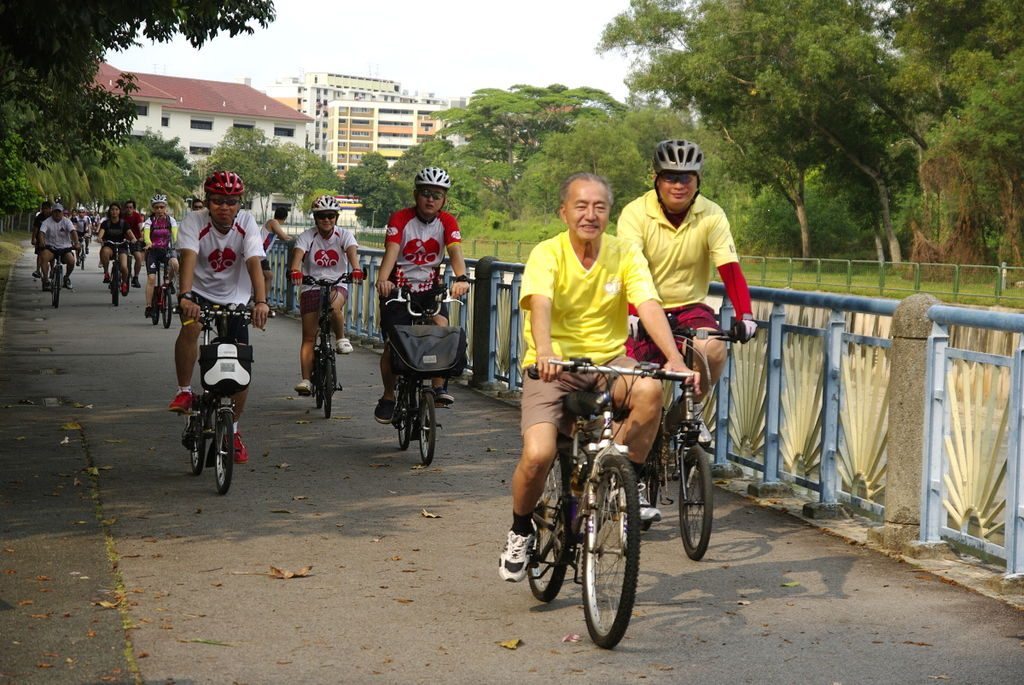
Photo via Wikimedia Commons
On the other hand, elderly persons who lack the social support of family or friends tend to experience deteriorating physical or mental health. Living alone and unsupervised, they are at a higher risk for falls, bad health, poor management of finances, and have a generally poor standard of living. Such a group of seniors are particularly vulnerable towards developing depression and, in extreme cases, suicidal tendencies. In Singapore, the incidence of elderly suicides has risen from “95 cases in 2010 to 126 cases in 2014”.
Japan’s Dementia Towns and Singapore’s “Elder Playgrounds”
Japan has introduced dementia towns as a way to care for the country’s burgeoning ageing population through a community-based approach. In dementia towns, caring for the elderly is not just the doctor, caregiver or family’s responsibility, but everyone’s: community members are trained on the signs of dementia and the steps to ensure their safety, and they keep a special eye out for the aged. The success of Japan’s dementia towns reinforces how crucial it is for elderly people to remain integrated with their community.
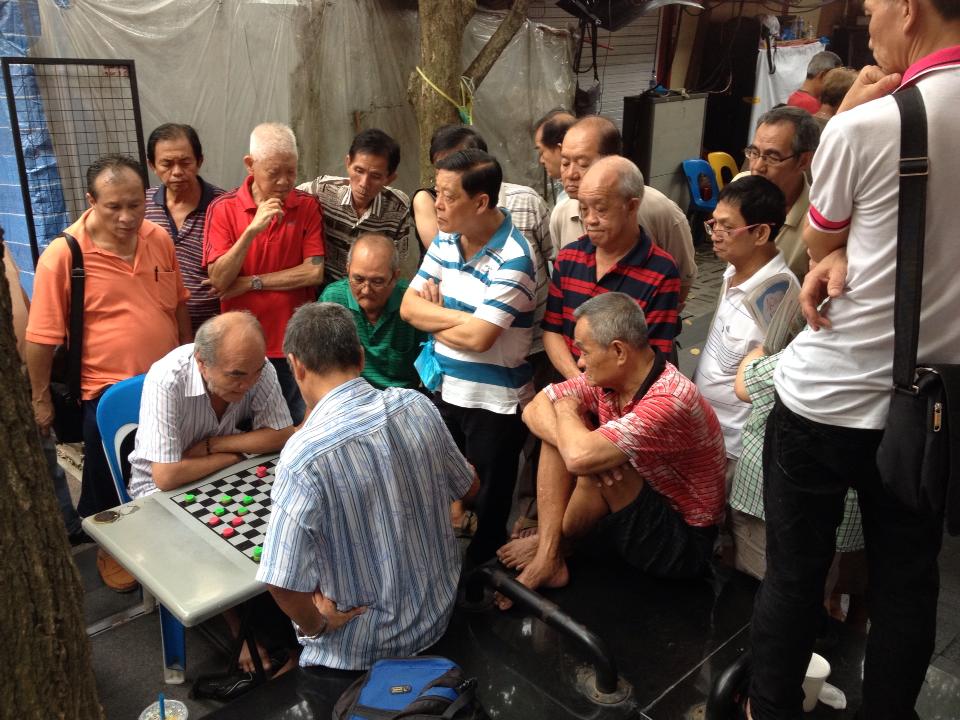
Photo via Wikimedia Commons
There presently exists a different sort of elderly-friendly public space in Singapore: “elder playgrounds”. Essentially open-air exercise stations located around most HDB neighbourhoods, seniors can go there to engage in light and safe physical activity. However, there is still room for more—and better—elder-inclusive infrastructure here. In 2017, the National Council of Social Service conducted a nationwide survey entitled “Quality of Life Study on Seniors”. Findings showed that Singapore’s elderly citizens were generally satisfied with the country’s infrastructure, especially in the areas of safety, public transportation and the physical environment, but less so when it came to the arts and culture. On the latter point, the majority of survey participants agreed that there were insufficient opportunities for continued learning and social and cultural recreation for older people.
Wellness and Longevity: Striking that Balance
With rising numbers of seniors in Singapore’s workforce, the older workers themselves must take conscious steps to ensure a healthy work–life balance. Yet not every “pioneer generation” individual feels they have the financial security to engage in pastimes or be active in their community; many instead throw themselves in work.
However, the importance of social inclusion cannot be overstated. Many experts agree that continuous learning through recreational activities is beneficial to one’s overall mental health and sense of purpose, and even helps reduce the odds of dementia and depression. In particular, participation in the arts has shown to be helpful for seniors, according to this study by the Nanyang Technological University. Elderly persons who partook in arts programmes reported higher levels of well-being, a heightened sense of purpose, increased satisfaction in physical and emotional health, among other things.
As Ms Lily Phang of Homage said, “it takes a village to take care of an elderly person.” Not only do we need the social support of various parties (individuals, family, community, organisations and the government) to help someone age in place, we (as a society) need to get used to discussing—and work towards normalising—topics like ageing and death. Regardless of one's age, all Singaporeans should be encouraged to think about their post-retirement years, and the youth especially should embrace the idea of ageing as a natural, unavoidable part of life—even a process that can be positive and enjoyable.
The government can also support this social movement by creating more elder-friendly public spaces, promoting greater awareness of age-related health conditions and encouraging community-based support for the vulnerable elderly. But while the government and social sector can do their part to boost the pioneer generation’s overall quality of life—especially in the cases of the unemployed and low-income elderly—it is also ultimately the responsibility of the individual to maintain their physical and mental health and engage in meaningful social interaction.
Elderly QOL planning can start today. Here are some suggestions.
- Imagine the kind of life you want in your old age: Think of ways that will help you stay independent, happy and connected. Are you already cultivating healthy habits right now that are helping you meet those goals?
- Adopt “active ageing” habits now: Don’t wait till we are 65 to work on your health and fitness. Start at your workplace, where you spend the bulk of your days—use a standing desk, take walking breaks, and climb the stairs instead of taking the lift. Outside the office, exercise regularly and eat a balanced diet. Your body begins to age from the age of 30, so it’s important to eat well and keep fit, even if you feel young and healthy.
- Start your retirement fund early: With longer life expectancy, your savings may not be able to cover all your healthcare needs. A sound financial plan will help you work towards financial security in your old age. You can also consider monetising your assets, such as taking up a reverse mortgage scheme for HDB flat leases.
- Have your support systems in place: Foster and maintain meaningful relationships with friends and family. Make time for them even in your busy life so you can count on each other in times of need. The Singapore government and society still views eldercare as the responsibility of families, so it’s also important to know if your family will take care of you in your old age, and if so, consider which family member is most suitable. If you’re single or without children, or simply prefer to live independently in your golden years, ensure that you have elderly-friendly installations in the home, such as slip guards and handrails, to both increase your ease of mobility and reduce the risk of falls.
- Be aware of help and resources: Take the time to read up on the various eldercare schemes offered by the government, social organisations, workplaces and communities. Get to know the groups that support senior citizens and familiarise yourself with elder-friendly spaces in your neighbourhood. You’ll never know when that information could help someone or even yourself.
Before I left Singapore, I returned to the Albert Food Centre, hoping to run into Mr Lim. I was eager to hear his comments about what I’d learned about Singapore’s elderly. Sadly for me, he wasn’t around that particular day. On my flight back to the States, I reflected on my time here, as well as my experiences with elderly communities in Thailand and China. That made me imagine what my own life as a senior citizen might be like. I was certain I did not wish to end up dependent and frail like the old man I saw in the Thai aged home; rather, if I could be as fortunate, I hope to be like one of those dancing folks I saw at the park in Beijing.
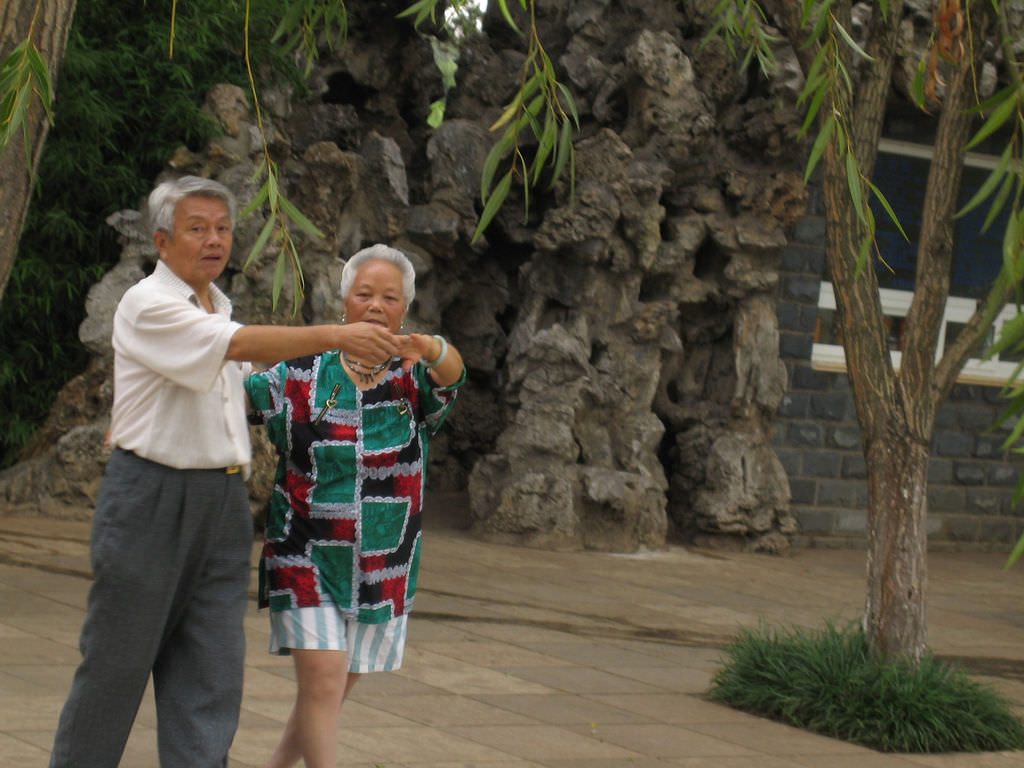 Photo by Eric Chan via Flickr
Photo by Eric Chan via Flickr
Granted we never know what will happen in the future—and I may be getting ahead of myself thinking about these issues as a twenty-year-old— but I think there’s something to be said about investing in a full, active life and fostering meaningful relationships, no matter our age. To me, those things make quality of life worth striving for.
Banner photo by Joan Campderrós-i-Canas via Flickr
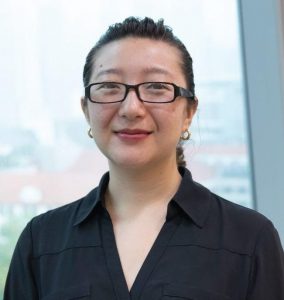 |
Stephanie Tran Rojas was a 2018 Summer Associate (Editorial) at the Lien Centre for Social Innovation. Born and raised in San Diego, California, she is a third-year nursing student from the University of Pennsylvania. She sees media and art as invaluable tools for social change, and believes that “with art, one can create an intimate connection between strangers that spans across time and space”. Stephanie is additionally interested in the media as a platform for public health campaigns and the use of literature to bring about ideological shifts. In her free time, she enjoys incorporating art into her daily life with dancing and writing. She can be reached at trojas@upenn.edu |








Comments